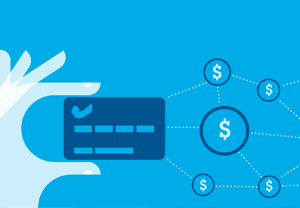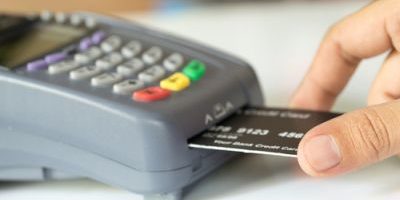According to the Identity Theft Resource Center, the number of data breaches reported in 2014 reached a record high. In the last few years, we’ve seen data breaches hit major retailers including Target, Home Depot and ebay, causing not only headaches for consumers, but cost on average $3.5 million.
The new EMV chip cards, which started rolling out in early October, aim to cut back on data breaches and fraudulent charges.
Here’s 5 things to know about the EMV Chip Cards
1. How to use it
Rather than swiping the card, you will insert the card into the bottom of the card reader (see below) and leave it for a few seconds. The machine will let you know when you can remove your card.
This method will take longer than the usual swipe you’re use to, but the vetting process is more secure than the current method.
2. Chip cards are more secure
Magnetic-stripe cards are outdated and have been for awhile. The problem with these cards is the payment processor uses the stripe to match it to your bank account information. This information remains static and can easily be captured and cloned by thieves. Devices that clone this data can be bought for as little as $20.
The data on chip cards, however, is dynamic, making it more difficult –and expensive–for thieves to steal your information and clone your card. When you are paying, the chip card uses a single-use code to finish the transaction. If a thief were to steal this code, the code wouldn’t do them any good.
3. Not all retailers are ready for the switch
The switch to EMV cards is not a mandate, instead it’s a shift, meaning not all retailers have switched over to the new machines yet. If a retailer hasn’t switched over and someone makes fraudulent purchases using your card, the retailer will be responsible for the charges.
You generally won’t be held responsible for fraudulent charges that you didn’t make.
4. Other Countries have had success using EMV technology
EMV cards have been used in Europe for more than a decade now. During that time, Europe saw credit card fraud drop more than 30 percent. Canada implemented chip cards in 2012 and saw card skimming losses drop more 70 percent. It is expected that the United States will see similar results during the next few years.
5. Chip cards won’t stop fraudulent charges
Unfortunately, chip cards won’t be the end of fraudulent charges and data breaches, but it will help combat the issue. For one thing, chip cards will still have the stripe making it susceptible to fraud. Additionally, online transactions won’t be made any safer by chip cards. So check your statements weekly to ensure no suspicious activity has occurred.
Conclusion:
For you, the consumer, EMV chip cards won’t change much other than how you use your card. Make sure to continue checking your monthly statements for any suspicious activity and if you notice anything out of the ordinary, contact your financial institution.
Have a question about the new EMV chip cards? Post it in the comments below.






